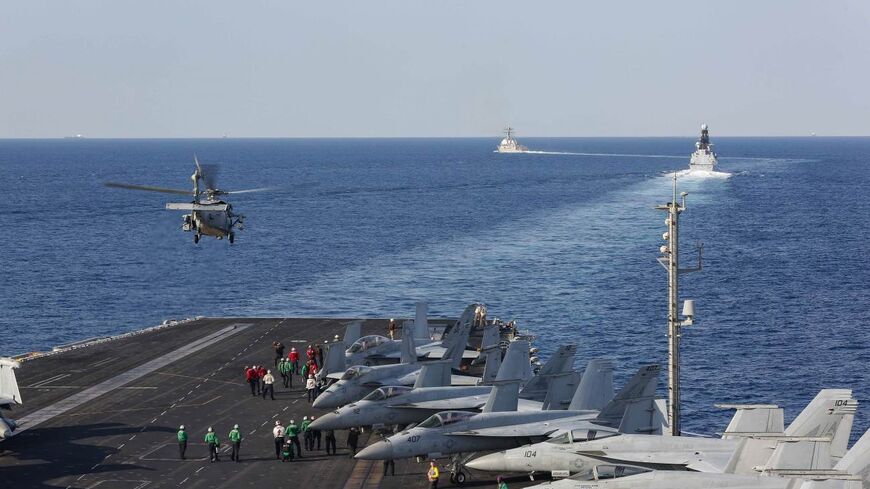WASHINGTON — The Senate’s Armed Services Committee advanced its version of next year’s defense spending bill on Friday with measures that lawmakers hope will continue building cooperation between Middle Eastern states to counter threats by Iran.
The Senate’s version builds on the current National Defense Authorization Act in calling on the Biden administration to improve maritime security and naval interdictions in the Persian Gulf amid continued arms smuggling, ship seizures and maritime drone strikes by Iran.
This year’s NDAA already requires the Pentagon to report to Congress on US efforts to build an integrated air and missile defense architecture between Middle Eastern countries designed to neutralize Iranian projectile attacks.
The Senate’s version of next year’s bill would further require Pentagon officials to provide updates on the effort, which has made significant strides over the past several months but remains limited by reluctance to share sensitive intelligence between some Arab militaries in the Gulf region.
The Senate’s bill would also require the Biden administration to improve regional cybersecurity cooperation between the US and Middle Eastern states, building off an earlier measure that sought to further military cybersecurity support for Jordan.
It would further direct the Biden administration to assess what benefits Iran may be receiving in return for its support for Russia’s war against Ukraine.
The House Armed Services Committee advanced its own version of next year’s NDAA on Wednesday. That bill is subject to further amendment once it goes to the floor, but is expected to eventually include measures furthering US support for Israel, including steps to help ensure Israel's ability to strike at Iran’s nuclear sites with less reliance on outside support.
Earlier this year, the Biden administration set a new precedent by green-lighting major war games with Israel that simulated long-range air strikes on strategic targets, closely resembling the air operations designed to knock out Iran’s nuclear sites.
Israeli top brass have long requested the exercises, as the IAF remains less capable of destroying Iran’s underground nuclear sites on its own than if it had US support, particularly due to its lack of adequate bunker-busting munitions and mid-air refueling tankers.
A measure introduced in the House by Indiana Republican Jim Banks would require similar “large-scale and long-range” airstrike exercises to be held bi-annually with Israel.
A separate measure from Rep. Brian Finstad (R-Minn.) to expedite Israel’s acquisition of Boeing’s KC-46A mid-air refueling tankers doesn’t appear to have made it in this week’s markups. Nor did a counterpart amendment expected to be introduced in the Senate by Sens. Tom Cotton (R-Ark.) and Gary Peters (D-Mich.) that would have forced the US to train Israeli pilots on US KC-46s deployed to Israel. Variations of those measures may yet be introduced.
Another widely anticipated amendment, the MARITIME Act introduced earlier this year by members of the House and Senate’s Abraham Accords caucuses, was also absent from the latest markups.
One amendment in the House’s version of the NDAA would require the Pentagon to provide updates on US munitions stored in Israel. The New York Times reported earlier this year that the Pentagon had withdrawn some of its forward stockpiles in order to supply Ukraine.
Other measures in the House version of the NDAA would require Pentagon officials to brief lawmakers on defense cooperation between China and Saudi Arabia as well as the UAE’s relations with Beijing; on Iran’s continued fortification of its nuclear enrichment sites; report on US national security implications should Middle Eastern states adopt 5G communication infrastructure; and report on how Beijing’s ties with Iran have benefited its ballistic missile program.
What’s next: Not all the measures included in this week’s markups may be included in the final versions as the proposals head to the floor.
Know more: After years of preventing the Air Force from retiring aging A-10 Warthog aircraft, the House and Senate included measures this week allowing the service to fulfill a longstanding plan to retire 42 of the planes next year.
Last year, Congress for the first time allowed the Air Force to mothball 20 of its A-10s, which first became operational in 1977 and were designed as Cold War-era tank-busters before seeing action in the Persian Gulf War in 1991.
More recently, the Pentagon deployed A-10s to the Middle East to backfill recent re-deployments as Washington focuses its forces in Europe and the Pacific to deter Russia and China.







